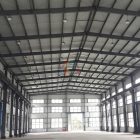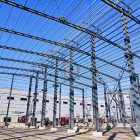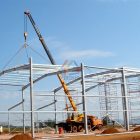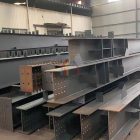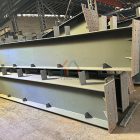How to building long-span steel structures?
With the rapid development of modern construction technology, long-span steel structures have been widely used in the construction field due to their unique advantages. The long-span steel structure is not only beautiful and elegant, but also structurally stable and durable. It is especially suitable for large stadiums, convention and exhibition centers and other buildings. So, how are long-span steel structures built?
1. Planning and preparation before construction
Detailed planning and design are required before the construction of long-span steel structures. First, determine the basic parameters such as the span, height, and load of the structure based on the building’s purpose, geographical location, climatic conditions and other factors. Then, through computer simulation analysis, the structural design is optimized to ensure the safety and economy of the structure. At the same time, a detailed construction plan needs to be formulated, including construction sequence, construction methods, construction equipment, etc.

2. Selection of construction methods
There are various construction methods for long-span steel structures. Common ones include segmented hoisting method, slip construction method, high-altitude bulk installation method, etc. Among them, the segmented lifting method is suitable for buildings such as large steel structure stadiums. The steel structure is divided into several small parts for lifting, and then spliced on the ground, and finally the whole is hoisted to the designed position. This method can greatly improve construction efficiency and shorten the construction period.
3. Key technologies in the construction process
- Welding technology: The welding quality of large-span steel structures directly affects the safety and stability of the structure. Therefore, during the welding process, advanced welding technology and equipment need to be used to ensure the quality of the weld. At the same time, professional training is also needed for welding workers to improve their operating skills.
- Lifting technology: In the segmented hoisting method, lifting technology is the key. Professional lifting equipment and steel cables are required to lift the steel structure from the ground to the designed position. During the lifting process, the lifting speed and height need to be strictly controlled to ensure the safety and stability of the structure.
- Installation technology: During the installation process of steel structures, precise measurement technology and positioning technology are required to ensure that the steel structure can be accurately installed at the designed location. At the same time, strict supervision and management of the installation process are also required to ensure installation quality.
4. Safety management of construction sites
There are many potential safety hazards during the construction of large-span steel structures, such as falling from heights and being struck by objects. Therefore, it is necessary to strengthen the safety management of construction sites. First of all, it is necessary to formulate a complete safety management system and emergency plan, and clarify responsibilities and authorities. Secondly, safety education and training should be provided to construction personnel to improve their safety awareness. Finally, inspections and supervision of construction sites should be strengthened to detect and deal with potential safety hazards in a timely manner.

The construction of long-span steel structures is a complex project that requires the comprehensive use of a variety of technologies and equipment. Through scientific planning and design, reasonable construction methods, superb construction technology and strict safety management, the safety, stability and quality of long-span steel structures can be ensured. In the future, with the continuous progress and innovation of construction technology, long-span steel structures will be applied and developed in more fields.


